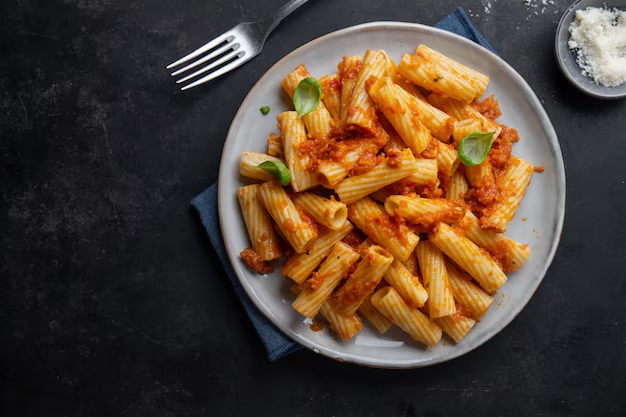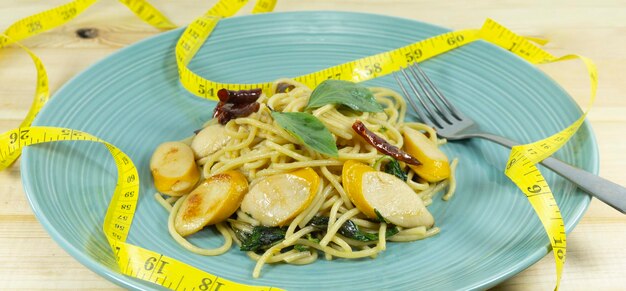When it comes to weight loss, pasta often finds itself on the “do not eat” list. People fear it because of its high carbohydrate content. But is pasta bad for weight loss? The answer depends on how it’s eaten. Pasta can be part of a healthy diet when consumed in the right way.
Portion control, ingredient choices, and preparation methods play crucial roles in determining its impact. In this article, we’ll debunk myths about pasta, discuss smart strategies for including it in your diet, and help you make informed choices without compromising your weight-loss goals.
Is Pasta Bad for Weight Loss?
Many people believe eating pasta automatically leads to weight gain. But this is a misconception. Let’s break it down.
Misconceptions About Pasta
The main weight concern with pasta is its carbohydrate content. Carbs are often unfairly blamed for weight gain. However, your body needs carbohydrates for energy. It’s not carbs but overconsumption of calories that causes weight issues.
Another misconception is that all pasta is the same. White, refined pasta has a higher glycemic index, which may cause quick spikes in blood sugar. But other options, like whole-grain or legume-based pasta, are healthier.
Importance of Portion Size
A standard serving of cooked pasta is about one cup. This contains approximately 200 calories. Many people, however, eat larger portions without realizing it. Eating three cups instead of one can add up to 600 calories or more. Proper portion control can prevent unnecessary calorie intake and make pasta a weight-loss-friendly choice.
Preparation Methods Matter
Pasta itself isn’t unhealthy. What you pair it with makes a difference. Creamy, cheese-laden sauces and processed meats can turn a low-calorie dish into a calorie bomb. Opt for tomato-based sauces or simple olive oil with herbs to keep your meal light and nutritious.
Can I Eat Pasta While Losing Weight?
Yes, you can eat pasta and still lose weight. The key is making informed choices.
Control Your Portions
Stick to recommended serving sizes. Measure your pasta before cooking to avoid overeating. Combine it with nutrient-dense foods to increase volume without adding extra calories.
Choose Healthy Ingredients
Instead of regular pasta, try whole-grain or alternative varieties made from lentils, chickpeas, or quinoa. These options are higher in fiber and protein, which can keep you fuller for longer.
Balance Your Plate
Combine pasta with vegetables, lean proteins, and healthy fats. Add roasted vegetables or a fresh salad to your pasta dish. Proteins like grilled chicken, shrimp, or tofu complement pasta and make meals more satisfying.
How to Eat Pasta for Weight Loss?
It’s all about the right strategy. Here are practical tips for enjoying pasta while keeping your weight-loss goals on track.

1. Opt for Whole-Grain or Low-Carb Pasta
Whole-grain pasta contains more fiber than white pasta. Fiber slows digestion and promotes a feeling of fullness. If you’re on a low-carb diet, look for pasta alternatives made from vegetables, such as zucchini noodles or spaghetti squash.
2. Add More Vegetables
Vegetables are low in calories and high in nutrients. Add spinach, broccoli, bell peppers, or mushrooms to your pasta. They add volume to your meal and help you eat less pasta overall.
3. Incorporate Lean Proteins
Proteins are essential for building and repairing tissues. Adding grilled chicken, turkey, or plant-based proteins like lentils to your pasta can make it a balanced meal. Protein also increases satiety, helping you feel full for longer.
4. Mind the Sauces
Choose light sauces made from tomatoes, olive oil, or herbs. Avoid heavy cream-based sauces, which are loaded with calories and unhealthy fats. A simple drizzle of olive oil with garlic and chili flakes can be just as flavorful.
Is Whole Wheat Pasta Bad for Weight Loss?
Whole wheat pasta is a better option for weight loss compared to refined pasta. Here’s why:
High Fiber Content
Whole wheat pasta is rich in fiber. Fiber slows digestion and keeps blood sugar levels stable. This helps in preventing cravings and overeating.
Promotes Satiety
Fiber adds bulk to your meals, making you feel fuller with fewer calories. This can reduce overall calorie consumption.
Low Glycemic Index
Whole wheat pasta has a lower glycemic index than white pasta. This means it causes a slower, steadier rise in blood sugar, which is beneficial for managing weight and preventing spikes in hunger.
Is Pasta Good for a Weight Loss Diet?
Pasta can be a part of a healthy diet when eaten in moderation. Here’s how to make it work:
1. Practice Moderation
Portion control is essential. Eating small portions of pasta as part of a balanced meal can provide energy without excessive calorie intake.
2. Balance with Other Foods
Pair pasta with vegetables, proteins, and healthy fats. This creates a balanced meal that supports your nutritional needs.
3. Avoid Over-Processed Additions
Stick to fresh, whole foods. Avoid processed meats like bacon or sausage and choose lean, unprocessed options instead.
4. Stay Active
Eating pasta doesn’t mean you’ll gain weight if you’re active. Exercise helps balance calorie intake and supports weight loss.
Healthy Pasta Options for Weight Loss
If you’re watching your weight, switching from traditional pasta to healthier alternatives can make a big difference.
1. Whole-grain pasta
Whole-grain pasta contains more fiber than regular white pasta. Fiber helps you feel fuller for longer, reducing the chances of overeating. It’s also more nutrient-dense, providing B vitamins, iron, and magnesium.
2. Chickpea and Lentil Pasta
Legume-based pasta, like chickpea or lentil pasta, are rich in protein and fibre. These nutrients support satiety and help maintain stable blood sugar levels, which is essential for weight management.
3. Low-Carb Pasta Options
For those following low-carb diets, there are innovative options like shirataki noodles or zucchini pasta. These alternatives are significantly lower in carbs and calories while still satisfying pasta cravings.
To Relate: Cappelletti Pasta Recipe
Best Pasta for Weight Loss
Finding the best pasta for weight loss depends on your dietary preferences and goals.
1. Zucchini Noodles
Zucchini noodles, or “zoodles,” are a fantastic low-calorie alternative. They are made from spiralized zucchini and are packed with vitamins and minerals.
2. Shirataki Noodles
Shirataki noodles, made from konjac yam, are extremely low in calories and carbs. They’re a great choice for those looking to cut down on calories without sacrificing volume.
3. High-Protein Pasta
Pastas made with pea or chickpea flour have higher protein content. This can support muscle maintenance and promote fullness.
Is Gluten-Free Pasta Bad for Weight Loss?
Gluten-free pasta can be beneficial if you choose the right type.
Nutritious Gluten-Free Options
Look for gluten-free pastas made from whole grains like quinoa or brown rice. These options provide fiber, vitamins, and minerals, unlike refined gluten-free varieties.
Beware of Processed Versions
Some gluten-free pastas are heavily processed and lack nutritional value. Always check the ingredient list for added sugars or artificial ingredients.
Pasta Alternatives for Weight Loss
Pasta alternatives offer a great way to enjoy your favorite dishes while keeping calories low.
1. Spiralized Vegetables
Spiralized veggies, such as zucchini, sweet potatoes, or carrots, are low-calorie and nutrient-rich substitutes for pasta.
2. Spaghetti Squash
This vegetable transforms into spaghetti-like strands when cooked. It’s an excellent low-calorie, high-fiber alternative.
3. Konjac Noodles
Also known as shirataki noodles, these are virtually calorie-free and absorb flavors well. They are great for soups, stir-fries, or pasta dishes.
Is White Pasta Bad for Weight Loss?
White pasta isn’t the best choice for weight loss due to its nutritional shortcomings.
High Glycemic Index
White pasta is made from refined flour, which has a high glycemic index. This means it can cause quick spikes in blood sugar, leading to increased hunger and cravings.
Lower Nutritional Value
Refined pasta lacks the fiber and nutrients found in whole-grain options. This can leave you feeling less satisfied and more likely to overeat.
Is Pasta Bad for Weight Loss at Night?
Eating pasta at night isn’t inherently bad, but there are considerations to keep in mind.

Portion Control
Stick to one serving size if you’re eating pasta in the evening. Overeating late at night can lead to unused calories being stored as fat.
Light Additions
Pair your pasta with light, low-calorie ingredients like steamed vegetables and lean proteins. Avoid heavy sauces and cheeses.
Activity Level
Your activity level during the day matters. If you’ve been active, your body is better equipped to use the carbs from pasta as energy rather than storing them.
How Much Pasta Can I Eat on a Diet?
Controlling how much pasta you eat is crucial for weight loss.
Stick to the Serving Size
A single serving of cooked pasta is about ½ cup to 1 cup, depending on your calorie needs. Measure your portions to avoid overeating.
Pair with Nutrient-Dense Sides
Add bulk to your plate with low-calorie, nutrient-dense sides like leafy greens or grilled vegetables. This keeps your meal satisfying without excessive calories.
Avoid Seconds
Resist the temptation to go back for more. Eating slowly and savoring your meal can help you feel full on smaller portions.
To Read: Is Fast Food Bad for Weight Loss? Healthy Alternatives
Is Pasta High in Carbs for Weight Loss?
Pasta is carb-dense, but that doesn’t mean it’s off-limits for weight loss.
Carb Content in Pasta
One cup of cooked pasta contains roughly 37-43 grams of carbohydrates. While this is significant, it can fit into a balanced diet when eaten in moderation.
Balance Your Meal
Combine pasta with lean proteins and non-starchy vegetables. This reduces the overall carb load and makes the meal more balanced.
Is Whole-Grain Pasta Better for Weight Loss?
Whole-grain pasta is an excellent choice for weight management.
Higher Fiber Content
Whole-grain pasta is rich in dietary fiber. Fiber slows digestion, keeping you fuller for longer and reducing hunger.
Nutrient-Dense
It provides essential nutrients like B vitamins and magnesium, which are often stripped from refined pasta. This makes whole-grain pasta a healthier and more satisfying option.
FAQs
1. Can pasta fit into a calorie deficit?
Yes, pasta can fit into a calorie deficit if consumed in controlled portions. Pair it with low-calorie, nutrient-rich ingredients like vegetables and lean proteins to keep meals satisfying and within your calorie limits.
2. Is cold pasta better for weight loss?
Cold pasta has resistant starch, which may help reduce hunger and improve digestion. This quality could support weight loss, especially when combined with healthy toppings like olive oil, lean proteins, and vegetables.
3. Is pasta bad for losing belly fat?
Pasta alone isn’t bad for belly fat. Excess calorie intake contributes to fat storage. Choose whole-grain or low-calorie pasta options and maintain a calorie deficit to support belly fat reduction.
4. Is pasta healthy or junk?
Pasta is not junk food if it’s made from whole grains or legumes and paired with healthy ingredients. Refined white pasta, however, lacks nutrients and may not be as beneficial for a balanced diet.
5. Is pasta fattening?
Pasta itself isn’t inherently fattening. Overeating or pairing it with calorie-dense sauces and toppings can lead to weight gain. Focus on portion sizes and nutrient-dense toppings for a healthier meal.
Conclusion
So, is pasta bad for weight loss? The answer is no—as long as you make smart choices. Opt for whole-grain or alternative pastas, watch your portions, and balance your meal with vegetables and proteins. By avoiding calorie-dense sauces and controlling your servings, pasta can be part of a healthy, weight-loss-friendly diet. Remember, moderation and mindful eating are key. With the right approach, you can enjoy your favorite dishes while staying on track with your goals.

